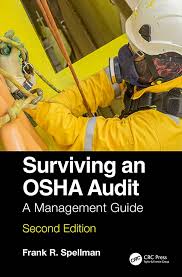Enhancing Workplace Safety: The Importance of an OSHA Audit

The Importance of OSHA Audits in Ensuring Workplace Safety
Workplace safety is a critical aspect of any organization, and the Occupational Safety and Health Administration (OSHA) plays a key role in setting and enforcing safety standards in the United States. One of the tools that OSHA uses to ensure compliance with these standards is through conducting OSHA audits.
What is an OSHA Audit?
An OSHA audit is a comprehensive review of an organization’s workplace safety practices to assess compliance with OSHA regulations. During an audit, trained OSHA inspectors visit the workplace to evaluate potential hazards, review safety protocols, and check for adherence to safety guidelines.
The Benefits of OSHA Audits
OSHA audits serve several important purposes:
- Identifying Hazards: By conducting audits, organizations can identify potential safety hazards in the workplace that may have been overlooked. This proactive approach helps prevent accidents and injuries.
- Ensuring Compliance: OSHA audits help ensure that organizations are following OSHA regulations and guidelines, reducing the risk of costly fines and penalties for non-compliance.
- Promoting a Culture of Safety: Regular audits emphasize the importance of workplace safety to employees, fostering a culture where safety is prioritized by all members of the organization.
- Improving Safety Practices: Audit findings can highlight areas where improvements are needed in safety procedures or training, leading to enhanced safety practices within the organization.
Tips for a Successful OSHA Audit
To prepare for an OSHA audit and ensure a successful outcome, organizations should consider the following tips:
- Educate Employees: Provide comprehensive training on safety protocols and procedures to all employees to ensure they understand their roles in maintaining a safe work environment.
- Maintain Documentation: Keep detailed records of safety inspections, training sessions, incident reports, and corrective actions taken to demonstrate compliance with OSHA standards.
- Conduct Self-Audits: Regularly conduct internal audits to identify and address potential hazards before an official OSHA audit takes place.
- Address Findings Promptly: If deficiencies are identified during an audit, take immediate action to address them and implement corrective measures as needed.
In Conclusion
OSHA audits play a crucial role in ensuring workplace safety by identifying hazards, promoting compliance with regulations, and improving overall safety practices within organizations. By proactively addressing safety concerns through audits, organizations can create safer work environments for their employees while avoiding potential legal consequences associated with non-compliance. Prioritizing workplace safety benefits not only employees but also contributes to increased productivity and morale within the organization.
Top 9 Frequently Asked Questions About OSHA Audits
- What is an OSHA audit?
- Why are OSHA audits important?
- Who conducts OSHA audits?
- What happens during an OSHA audit?
- How often should organizations conduct OSHA audits?
- What are the common areas that OSHA audits focus on?
- What are the consequences of failing an OSHA audit?
- How can organizations prepare for an upcoming OSHA audit?
- Are there resources available to help with OSHA compliance and audits?
What is an OSHA audit?
An OSHA audit is a comprehensive evaluation conducted by trained OSHA inspectors to assess an organization’s compliance with Occupational Safety and Health Administration regulations. During an OSHA audit, inspectors visit the workplace to identify potential safety hazards, review safety protocols, and ensure adherence to established safety guidelines. The primary goal of an OSHA audit is to promote and maintain a safe work environment by identifying areas for improvement, enhancing safety practices, and ultimately reducing the risk of workplace accidents and injuries.
Why are OSHA audits important?
OSHA audits are essential for ensuring workplace safety and compliance with regulatory standards set by the Occupational Safety and Health Administration. These audits play a crucial role in identifying potential hazards, evaluating safety practices, and promoting a culture of safety within organizations. By conducting OSHA audits, businesses can proactively address safety concerns, prevent accidents and injuries, and demonstrate their commitment to providing a safe working environment for employees. Compliance with OSHA regulations not only protects the well-being of workers but also helps organizations avoid costly fines and penalties associated with non-compliance. Overall, OSHA audits are instrumental in fostering a safer, healthier, and more productive work environment for all stakeholders involved.
Who conducts OSHA audits?
OSHA audits are typically conducted by trained OSHA inspectors who are authorized to assess workplace safety practices and ensure compliance with OSHA regulations. These inspectors have the expertise and knowledge to identify potential hazards, review safety protocols, and evaluate adherence to safety guidelines within an organization. Their role is crucial in promoting a safe work environment and helping organizations maintain compliance with OSHA standards to prevent accidents and injuries in the workplace.
What happens during an OSHA audit?
During an OSHA audit, trained inspectors visit a workplace to conduct a thorough assessment of safety practices and compliance with OSHA regulations. Inspectors typically review safety protocols, examine workplace conditions for potential hazards, assess employee training on safety procedures, and check documentation related to safety practices. The goal of an OSHA audit is to identify any areas of non-compliance with regulations, highlight potential safety risks, and provide recommendations for improving workplace safety standards. Organizations should be prepared to cooperate with inspectors, address any identified deficiencies promptly, and demonstrate a commitment to maintaining a safe work environment for their employees.
How often should organizations conduct OSHA audits?
Organizations should conduct OSHA audits regularly to ensure ongoing compliance with safety regulations and to maintain a safe work environment for employees. The frequency of OSHA audits may vary depending on factors such as the size of the organization, the nature of its operations, and any previous compliance issues. Generally, it is recommended that organizations conduct OSHA audits at least annually or whenever there are significant changes in workplace conditions or processes. Regular audits help identify potential hazards, address compliance issues promptly, and promote a culture of safety within the organization. By prioritizing the frequency of OSHA audits, organizations can proactively mitigate risks and enhance workplace safety standards.
What are the common areas that OSHA audits focus on?
During OSHA audits, inspectors typically focus on common areas such as hazard communication, personal protective equipment (PPE) usage, emergency action plans, machine guarding, electrical safety, fall protection, and overall workplace ergonomics. These key areas are crucial for ensuring the safety and well-being of employees in various industries. By examining these specific aspects closely, OSHA aims to identify potential hazards, assess compliance with safety regulations, and promote a culture of workplace safety that prioritizes the health and welfare of all workers.
What are the consequences of failing an OSHA audit?
Failing an OSHA audit can have serious consequences for organizations. Non-compliance with OSHA regulations can result in hefty fines and penalties, which can significantly impact the financial health of a business. Additionally, failing an OSHA audit can damage the organization’s reputation and credibility, leading to potential loss of customers, partners, and employees’ trust. Moreover, repeated violations or a pattern of non-compliance may trigger more frequent inspections and scrutiny from regulatory authorities, further increasing the risk of legal action and sanctions. It is crucial for organizations to prioritize workplace safety and proactively address any issues identified during an OSHA audit to avoid these detrimental consequences.
How can organizations prepare for an upcoming OSHA audit?
Organizations can prepare for an upcoming OSHA audit by taking several proactive steps to ensure compliance and readiness. First and foremost, it is crucial to familiarize oneself with OSHA regulations and requirements relevant to the specific industry and workplace. Conducting internal safety audits, addressing any identified hazards or deficiencies, and maintaining accurate records of safety training and incidents are essential preparatory measures. Additionally, providing comprehensive safety training to employees, designating a point person responsible for OSHA compliance, and conducting mock audits can help organizations assess their readiness and identify areas for improvement before the official audit. By prioritizing a culture of safety, documentation, and proactive measures, organizations can enhance their preparedness for an OSHA audit and demonstrate a commitment to maintaining a safe work environment.
Are there resources available to help with OSHA compliance and audits?
For organizations seeking assistance with OSHA compliance and audits, there are various resources available to provide guidance and support. OSHA’s official website offers a wealth of information, including regulations, standards, and educational materials to help businesses understand and meet safety requirements. Additionally, OSHA provides consultation services for small businesses looking to improve their safety programs and address potential hazards. Many industry associations and professional organizations also offer training programs, workshops, and resources specifically tailored to OSHA compliance and audit preparation. By utilizing these resources, organizations can enhance their safety practices, ensure regulatory compliance, and proactively address any issues that may arise during OSHA audits.



